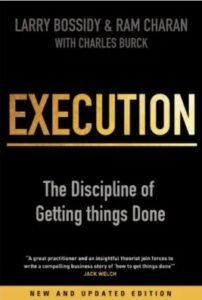 I was in two minds – whether to post a book summary of “Execution – The Discipline of Getting Things Done” a book that was first published in 2002. A simple thought that struck me – does the two decade old wisdom still hold? I decided to carry out a fact check if some new thinking has emerged in Strategy execution and if there has been an improvement in the metrics over the last 2+ decades. To my surprise, although there has been a marginal improvement in number of organizations achieving two-thirds of their intended strategic objectives, a large number (~ 85%) of organizations are still grappling with the challenges presented by Larry Bossidy and Ram Charan nearly two decades ago. Digital adaptability is a dimension that has got added to challenges.
I was in two minds – whether to post a book summary of “Execution – The Discipline of Getting Things Done” a book that was first published in 2002. A simple thought that struck me – does the two decade old wisdom still hold? I decided to carry out a fact check if some new thinking has emerged in Strategy execution and if there has been an improvement in the metrics over the last 2+ decades. To my surprise, although there has been a marginal improvement in number of organizations achieving two-thirds of their intended strategic objectives, a large number (~ 85%) of organizations are still grappling with the challenges presented by Larry Bossidy and Ram Charan nearly two decades ago. Digital adaptability is a dimension that has got added to challenges.
While there are various studies conducted on strategy execution since 2020, I found the recent study conducted in April – May 2023, by Economist Impact, “Bridging the Gap: turning Strategy into reality” to be more compact with a clear call to action.
Leveraging insights from desk research to global survey of over 600 executives across seven countries and six industries, the study aimed at understanding how businesses can become more skilled at strategy execution.
The key recommendations of the study are:
1. Align Key Stake holders during both strategy design and implementation
2. Drive accountability through targeted outcome based performance metrics – monitoring and holistic data management systems.
3. Prioritize strategic management initiatives to improve resource allocation.
4. Embed agility in strategy design, planning and implementation
5. Build a culture that reinforces strategic objectives
The central premise of the book Execution: The Discipline of Getting Things Done is no different. The real challenge of business continues to be execution of strategies rather than formulating the Strategy itself. Bossidy and Charan argue that execution is a discipline in its own right with specific set of behaviors and techniques that companies need to master in order to have competitive advantage.
Execution has always been thought of as “something – not strategic” and hence often gets delegated. In fact, it should be the primary responsibility of the leader.
Inspired by Zsolt’s visual thinking, I have summarized the entire book on one page.
The discipline of Execution hinges on seamlessly integrating the three fundamental business processes: people, strategy, and operations. Integrating these processes effectively leads to formidable results. “Execution” also explores the impact of organizational culture on execution, highlighting the importance of creating a culture that values execution and holds individuals accountable for results. The authors provide examples from various companies to illustrate how a culture focused on execution can drive success.
It is the responsibility of the business leadership to guide the teams in these processes. Needless to say, a well-executing company is resilient to business environment changes and the ability to execute is what differentiates the successful Companies from the rest.”
Spoken in first person by the authors, Larry Bossidy and Ram Charan, the contents of the book (in three sections) unfold in the form of a commentary. The authors establish authenticity by citing real life stories taken from Global companies. These stories provide deep insights and many of them you will find, resonate with your own experiences in the corporate world.
While “Execution” has been praised for its pragmatic approach to business success, critics have noted some limitations. Some argue that the book underestimates the complexity of executing strategies in rapidly changing environments, where adaptability and innovation are also crucial. Others suggest that the book’s strong focus on leadership involvement in execution might not fully address the need for employee empowerment and bottom-up innovation. Additionally, the emphasis on rigid processes and accountability could, in some interpretations, stifle creativity and flexibility in certain organizational cultures.
Despite these critiques, “Execution” remains a seminal work, offering valuable insights into the discipline of getting things done. It challenges leaders to not only devise strategies but also master the art of execution to drive their organizations forward.






Hi Vinayak,
Thanks for creating this blog and introducing books which are compelling needs for the professionals. We are spending very less time or nill for reading books. Even though I have read this book long time back but it was a refresher for me. Its a must read book for all professionals especially in operations. The way Lary & Ram written, it was very interesting. Thanks for taking this book and written it very well with the clear articulation. All the best!
Thank you so much